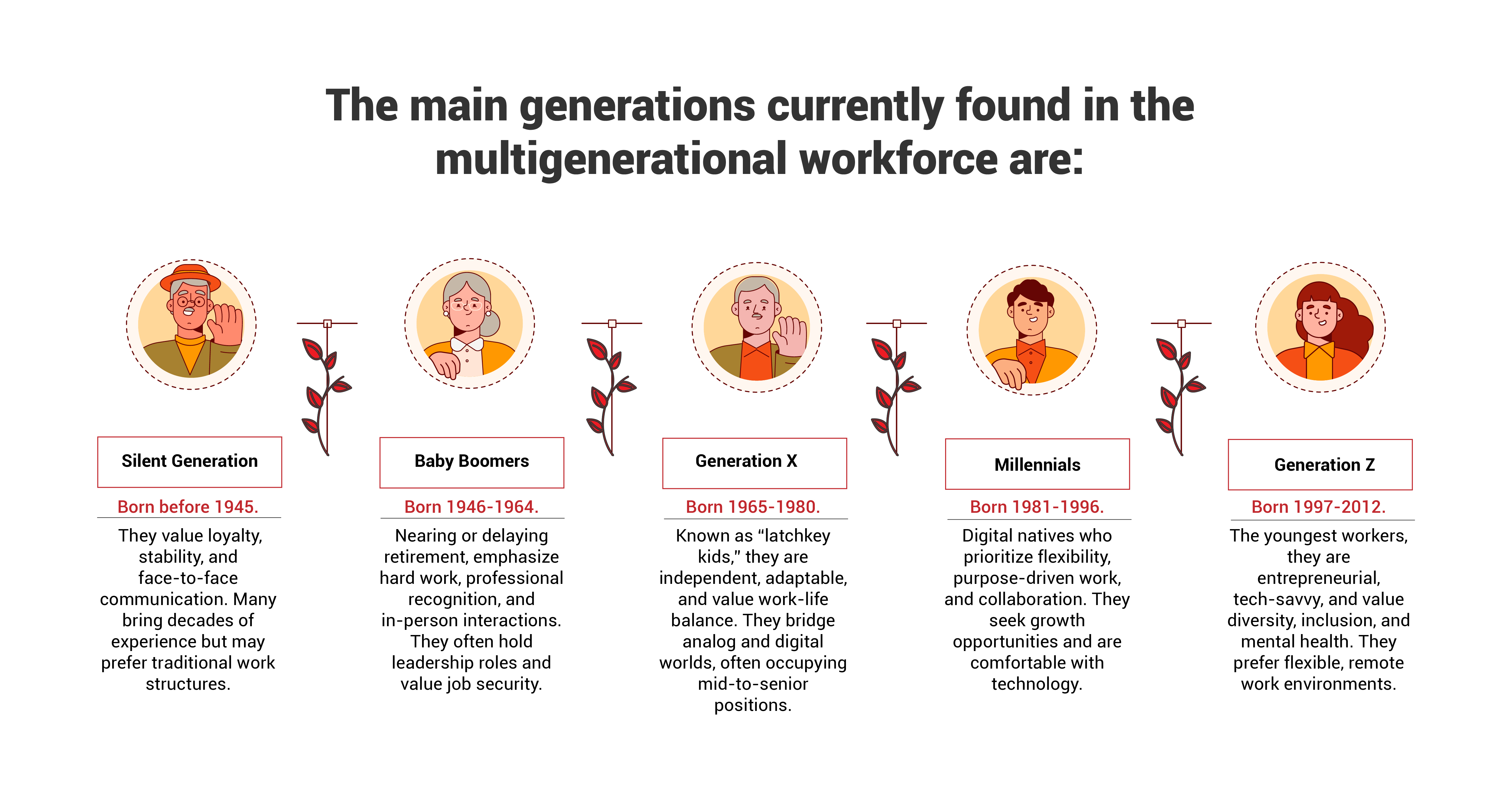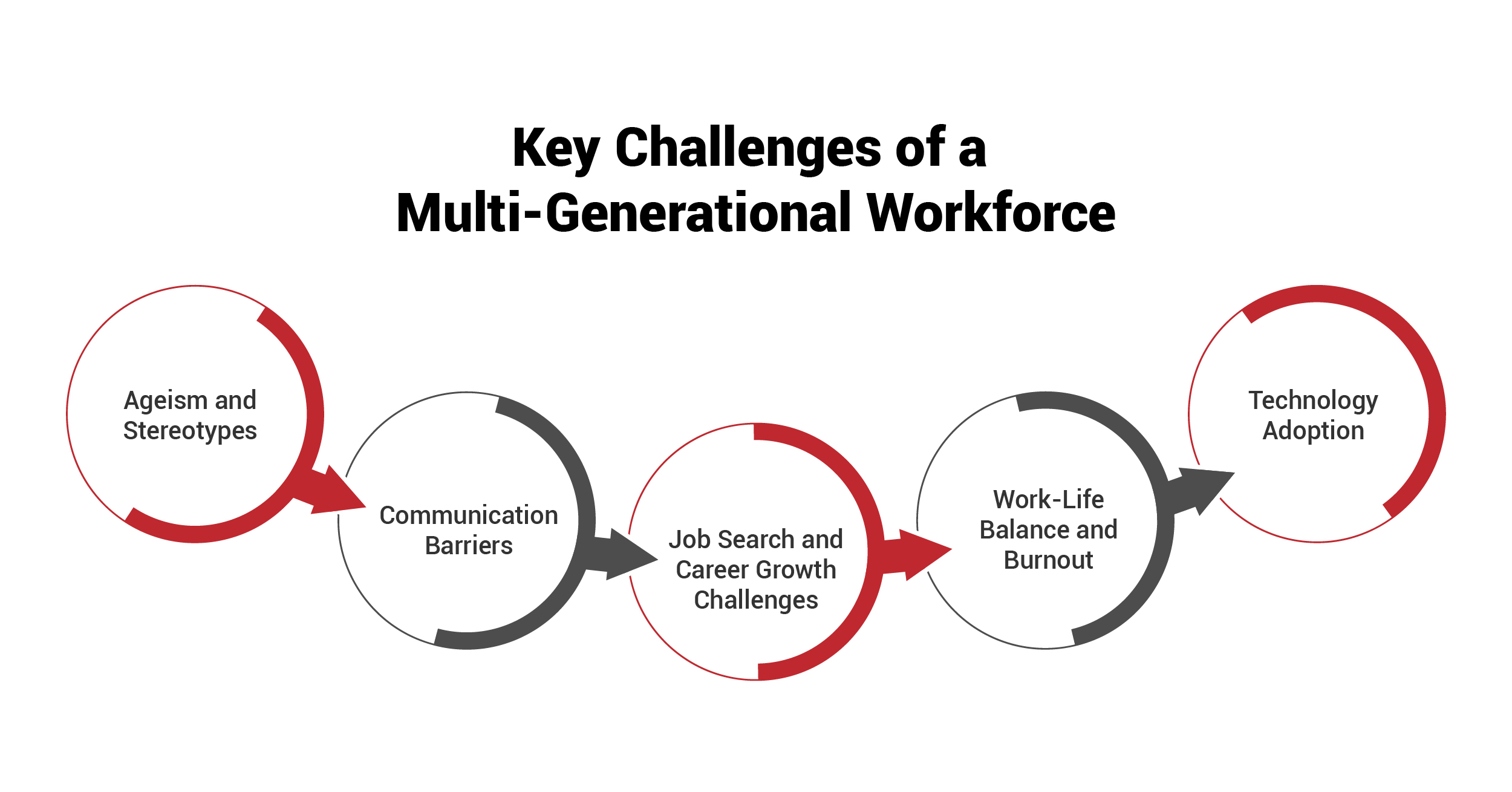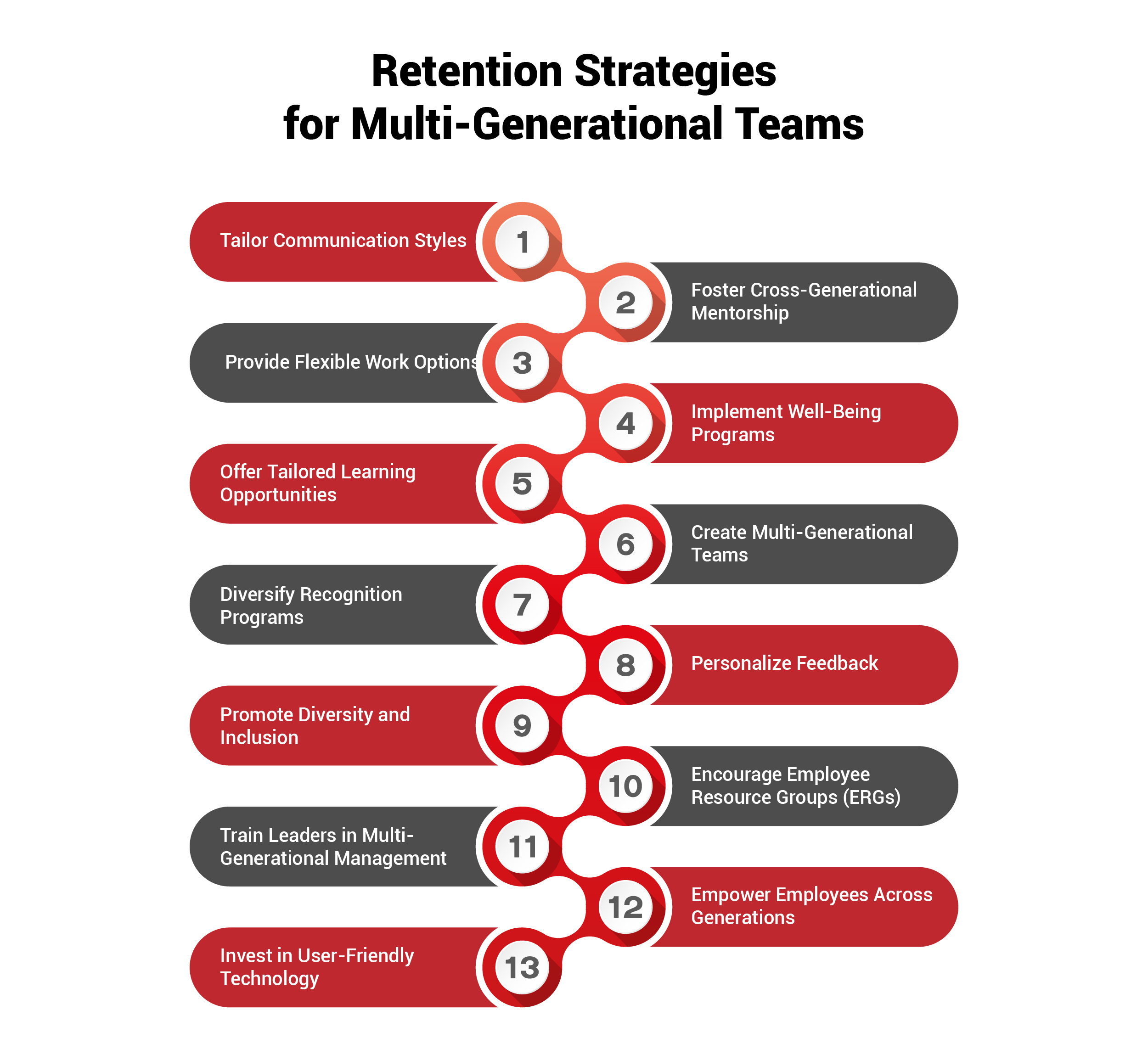In 2025, workplaces are more diverse than ever, with up to five generations—Silent Generation, Baby Boomers, Generation X, Millennials, and Generation Z—working side by side. Each generation brings unique perspectives, skills, and expectations, creating both opportunities and challenges for employers. According to a 2024 SHRM report, 70% of organizations face challenges managing multi-generational teams. However, when managed effectively, this diversity can drive innovation, enhance collaboration, and boost productivity.
This article explores the dynamics of a multi-generational workforce, offering practical strategies for gathering data on generational needs, retaining talent, managing diverse teams, and motivating employees of all ages. By fostering an inclusive environment, businesses can unlock the full potential of their workforce.
A multi-generational workforce spans employees from their early 20s to their 70s or beyond, each shaped by distinct historical, cultural, and technological contexts. Here’s a snapshot of the generations in today’s workplace.
These generational differences influence job search habits, career aspirations, workplace preferences, and communication styles. Gathering data on these nuances is critical for tailoring effective management strategies.
Managing a diverse workforce requires addressing challenges that arise from generational differences. Here are the primary hurdles, supported by insights from recent research:
Age discrimination affects both older and younger workers. According to iHire’s 2025 report, 36.8% of Baby Boomers and 39.7% of Gen Zers report being treated differently due to their age, compared to 28.1% of Gen Xers and 28.6% of Millennials. Stereotypes—such as “Boomers resist technology” or “Gen Zers lack work ethic”—fuel bias, with over 40% of each generation believing employers hold untrue perceptions about them.
Generations prefer different communication methods. Baby Boomers favor in-person or phone conversations, while Millennials and Gen Z lean toward digital platforms like Slack or instant messaging. ResearchGate notes that aligning communication styles improves organizational effectiveness, yet misaligned preferences can lead to misunderstandings or delayed decisions.
Job search struggles are universal but vary in intensity. iHire’s survey found that all generations struggle with finding qualified roles (30.7% Boomers, 30.3% Gen X, 32.0% Millennials, 33.7% Gen Z) and face frustration from employer ghosting (29.3% Boomers, 35.7% Gen X, 28.6% Millennials, 35.8% Gen Z). Basic skills like interviewing and resume writing remain challenging across ages, with 25.7% of Millennials and 18.8% of Boomers struggling to interview confidently.
Younger generations prioritize work-life balance more than their older counterparts. iHire’s data shows 43.1% of Gen Z and 42.9% of Millennials value work-life balance as a top employer offering, compared to 31.8% of Gen X and 23.4% of Boomers. Stress and burnout are particularly concerning for Gen Z (46.2%) and Millennials (39.7%).
While Millennials and Gen Z adopt technology rapidly, Boomers and Gen X may require more training. However, many older workers are tech-savvy from years of on-the-job learning. The key is ensuring accessible training for all.
Despite challenges, a multi-generational workforce offers significant advantages:
To retain, manage, and motivate a multi-generational workforce, employers must adopt inclusive, flexible strategies. Below are 13 actionable approaches.
Offer a mix of communication channels to suit all preferences. Baby Boomers may prefer face-to-face meetings, while Gen Z thrives on instant messaging. Tools like UnSpot’s Hybrid Schedule can organize in-person and virtual interactions, ensuring everyone feels included.
Pair employees from different generations to share knowledge. For example, a Boomer can mentor a Millennial on leadership, while a Gen Z employee teaches digital tools. IBM’s learning pods demonstrate how mixed-generation groups accelerate development.
Flexibility is key to meeting diverse needs. 94% of workers consider flexible options critical for job satisfaction. Offer remote work, compressed workweeks, or adjustable hours to support Gen X’s caregiving responsibilities or Gen Z’s preference for hybrid setups.
Address generational well-being needs with tailored programs. Boomers may value retirement planning, while Millennials and Gen Z benefit from mental health resources. Comprehensive initiatives reduce burnout and enhance engagement.
Provide diverse training formats, from in-person workshops for Boomers to e-learning platforms for Gen Z. The World Economic Forum predicts 50% of employees will need reskilling by 2025, making accessible learning essential.
Form project teams with diverse age groups to encourage collaboration. Google’s innovation sprints show how mixed teams spark creativity and blend experience with new perspectives.
Customize rewards to align with generational motivations. Boomers may appreciate monetary bonuses, while Millennials and Gen Z value growth opportunities or public recognition. A mix of rewards boosts morale across the board.
Deliver feedback in ways that resonate. Boomers and Gen X prefer formal sessions, while Millennials and Gen Z favor real-time, informal feedback. A flexible approach ensures all employees feel supported.
Strong DEI policies foster age-inclusive environments. McKinsey’s report suggests diverse organizations can gain $12 trillion in GDP by narrowing gaps, highlighting the value of inclusive HR practices.
ERGs provide platforms for employees to share experiences and advocate for their needs. These groups help HR leaders gather data on generational preferences, shaping better policies.
Equip leaders with skills to manage diverse teams. Training should focus on adaptive communication, conflict resolution, and inclusive decision-making to bridge generational gaps.
Give employees autonomy to make decisions, particularly appealing to Gen X and Millennials. Ensure resources and support are available to all, fostering a sense of ownership.
Provide intuitive tools like Microsoft Teams or Zoom, paired with training, to ensure accessibility for all generations. This bridges tech gaps and enhances collaboration.
Summary:
Retention requires personalized strategies that address generational needs:
Motivation hinges on aligning work with generational values:
HR leaders can implement these strategies by:
Tools like Rippling streamline workforce management by automating schedules, monitoring burnout, and supporting flexible work arrangements.
These examples highlight how leading companies apply retention strategies to engage a multi-generational workforce.
IBM, a global technology leader, has implemented learning pods to foster cross-generational mentorship, aligning with strategy. These small, diverse groups pair senior employees (often Boomers or Gen X) with younger professionals (Millennials and Gen Z) to share expertise. For example, a Boomer IT specialist might mentor a Millennial on project management, while a Gen Z employee teaches cloud computing tools like IBM Watson.
In 2023, IBM reported that 70% of participants in these pods felt more engaged, and retention rates for younger employees increased by 15% due to career development opportunities. This approach not only bridges generational skill gaps but also builds a collaborative culture, as noted in IBM’s workforce diversity reports.
Google, known for its innovative culture, leverages mixed-generation teams (strategy #6) to drive creativity and retention. In its “20% time” program, employees from different age groups collaborate on passion projects, such as developing new features for Google Search.
A 2022 initiative saw a Boomer product manager, a Gen X engineer, and a Gen Z UX designer create a sustainability-focused search tool, blending strategic insight, technical expertise, and modern design trends.
Google’s internal data showed a 20% increase in project success rates for diverse teams, with 85% of participants reporting higher job satisfaction. This strategy fosters mutual respect and retains talent across the multi-generational workforce.
In 2025, a multi-generational workforce is both a challenge and an opportunity. By gathering data on generational preferences and implementing inclusive strategies, employers can retain, manage, and motivate talent of all ages. From tailored communication to flexible work options, these approaches foster collaboration, innovation, and productivity. As Steve Flook, iHire’s CEO, notes, “Our research aims to inspire organizations to nurture inclusive work environments that attract and engage employees of all ages, thereby expanding their talent pools, sparking innovation, and increasing resilience.”
By embracing generational diversity, businesses can build a cohesive, dynamic workforce ready to thrive in the future.
This website uses cookies to enhance website functionalities and improve your online experience. By browsing this website, you agree to the use of cookies as outlined in our privacy policy .